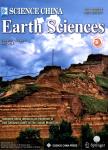Mineralogical evidence of water activity in the northern lowlands of Mars based on inflight-calibrated spectra from the Zhurong rover
作者机构:Key Laboratory of Earth and Planetary PhysicsInstitute of Geology and GeophysicsChinese Academy of SciencesBeijing 100029China
出 版 物:《Science China Earth Sciences》 (中国科学(地球科学英文版))
年 卷 期:2023年第66卷第11期
页 面:2463-2472页
核心收录:
学科分类:07[理学] 0708[理学-地球物理学] 070401[理学-天体物理] 0704[理学-天文学]
基 金:funded by the National Key Research and Development Program of China (Grant No. 2022YFF0504000) the Key Research Program of the Chinese Academy of Sciences (Grant No. ZDBS-SSW-TLC00106) the Key Research Program of the Institute of Geology and Geophysics, Chinese Academy of Sciences (Grant No. IGGCAS-202102) the Youth Innovation Promotion Association of the Chinese Academy of Sciences (Grant No. 2023071),the Young Elite Scientists Sponsorship Program by CAST (Grant No. 2021QNRC001)
主 题:Mars Water activity In-situ exploration Short-wave infrared spectrum Zhurong rover
摘 要:Hydrated minerals provide direct indications of the early Martian water environment. The various clay minerals and evaporite salts found to date are mainly exposed in the ancient southern highlands of Mars. While it is believed that the area of the northern lowlands could have hosted a global ocean in the past, its surface is covered with a layer of spectrally nonabsorbing materials, and orbital hyperspectral remote sensing has found only sparse evidence for the presence of water. China s first Mars exploration mission, Tianwen-1, landed in the putative ancient shoreline zone of the northern lowlands of Mars. Its rover,Zhurong, conducted high-spatial-resolution reconnaissance to reveal the geological and environmental evolution of this *** to frequent dust storms, not only is the Martian surface covered with dust, but also the spectral calibration panels on the rover are affected by dust coverage. Data from the shortwave infrared(SWIR) spectrometer onboard the rover are also affected by other environmental factors such as instrumental temperature changes and atmospheric carbon dioxide absorption. This study recalibrated the in situ SWIR data to minimize the impact of the above factors. The recalibrated spectral data show that the reflectance of the landing area falls within the normal range of Martian soil, and confirm the presence of several important absorption peaks. The absorption characteristics indicate the presence of polyhydrated sulfates, gypsum, and hydrated silicates in the surface materials along the rover track, with sulfate content of 27–39 wt.%. Our results further confirm past activity of liquid water in the Zhurong rover landing area, providing mineralogical evidence supporting hypotheses related to underground water or an ancient shoreline.



